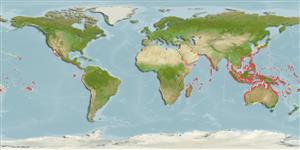Teleostei (teleosts) >
Tetraodontiformes (Puffers and filefishes) >
Tetraodontidae (Puffers) > Tetraodontinae
Etymology: Torquigener: Latin, torquere = to twist + Latin, generare = birth, race (Ref. 45335).
More on author: Bleeker.
Environment: milieu / climate zone / depth range / distribution range
Ecology
Marine; brackish; demersal; depth range 18 - 22 m (Ref. 26165). Tropical
Indo-Pacific: South Africa (Knysna), Mozambique, Tanzania and Madagascar; elsewhere to Indonesia, Japan (Ryukyu Is.) and Samoa.
Size / Weight / Age
Maturity: Lm ? range ? - ? cm
Max length : 13.0 cm TL male/unsexed; (Ref. 116289); max. published weight: 46.00 g (Ref. 116289)
Dorsal soft rays (total): 8 - 9; Anal soft rays: 7 - 8. This species is distinguished by the following: with spinules between nasal organs and dorsal fin
origin; upper body with dark brown reticulations; distinctive solid dark brown band from above the pectoral-fin bases to caudal-fin base; many small dark brown spots on the cheek forming broad
vertical bands separated by irregular narrow white bands; belly white (Ref. 127964).
Inhabits small loose groups on shallow coastal sand flats and in estuaries. Often sleeps during the day by burrying itself under the sand with just eyes exposed (Ref. 48637, 127964).
Life cycle and mating behavior
Maturity | Reproduction | Spawning | Eggs | Fecundity | Larvae
Heemstra, P.C., E. Heemstra, D.A. Ebert, W. Holleman and J.E. Randall (eds.), 2022. Coastal fishes of the Western Indian Ocean Vol. 5. South African Institute for Aquatic Biodiversity, a National Research Facility of the National Research Foundation (NRF-SAIAB), 632 p. (Ref. 127964)
IUCN Red List Status (Ref. 130435: Version 2024-1)
Threat to humans
Harmless
Human uses
Fisheries: of no interest
Tools
Special reports
Download XML
Internet sources
Estimates based on models
Preferred temperature (Ref.
123201): 22.9 - 29, mean 27.6 °C (based on 144 cells).
Phylogenetic diversity index (Ref.
82804): PD
50 = 0.5000 [Uniqueness, from 0.5 = low to 2.0 = high].
Bayesian length-weight: a=0.01349 (0.00689 - 0.02643), b=2.89 (2.72 - 3.06), in cm total length, based on LWR estimates for this species & (Sub)family-body (Ref.
93245).
Trophic level (Ref.
69278): 3.3 ±0.2 se; based on size and trophs of closest relatives
Resilience (Ref.
120179): High, minimum population doubling time less than 15 months (Preliminary K or Fecundity.).
Fishing Vulnerability (Ref.
59153): Low vulnerability (10 of 100).
